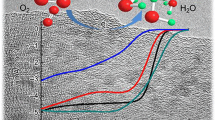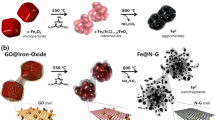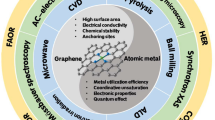Abstract
Molecular catalysts dispersed on nanocarbon substrates represent a unique class of single atom catalysts (SACs) for their well-defined active sites and tailorable structures, and are promising substitutes to precious metals for catalyzing the technologically important oxygen reduction reaction (ORR). Herein, we develop a highly active ORR catalyst consisting of iron phthalocyanine uniformly and densely dispersed on puff-like graphene (FePc/PG). With the unique crumpled and spheroid morphology, the graphene carrier possesses a large surface area and multiscale porosity, benefiting the high-density loading of FePc, exposure of the active sites and mass transfer efficiency during catalysis. When evaluated by a rotating disk electrode, FePc/PG presents a high half-wave potential of 0.909 V vs. the reversible hydrogen electrode. Furthermore, when employed as the gas diffusion electrode, FePc/PG exhibits outstanding high-rate and highpower capabilities at practically high current densities. This work provides efficient strategies to engineer the morphology of the nanocarbon substrates to design high-performance heterogeneous molecular catalysts toward applications in diverse energy conversion and storage technologies.

摘要
分散在纳米碳基底上的分子催化剂由于具有明确的活性位点和结构可调的特点, 成为了一类独特的单原子催化剂, 有望代替贵金属催化剂用于电催化氧还原反应. 本文中, 我们开发了一种高活性氧还原催化剂, 该催化剂由均匀且密集分散在泡芙状石墨烯载体上的铁酞菁(FePc/PG)构成. 泡芙状石墨烯载体由于具有独特的皱褶和球状形貌, 具有较大的比表面积和多尺度的孔结构, 有利于FePc的高密度负载、 活性位点的暴露和催化过程中传质效率的提高. 当用旋转圆盘电极评估性能时, FePc/PG表现出优异的半波电位, 达0.909 V (相对于可逆氢电极). 此外, 当用作气体扩散电极时, FePc/PG在高电流密度下表现出优异的高倍率和高功率性能. 这项工作为设计纳米碳材料的形貌以及高性能异相分子催化剂提供了有效的策略, 有望在多种能源转换和存储技术中得到应用.
Similar content being viewed by others
Reference
Zaman S, Huang L, Douka AI, et al. Oxygen reduction electrocatalysts toward practical fuel cells: Progress and perspectives. Angew Chem, 2021, 133: 17976–17996
Peng L, Shang L, Zhang T, et al. Recent advances in the development of single-atom catalysts for oxygen electrocatalysis and zinc-air batteries. Adv Energy Mater, 2020, 10: 2003018
Nie Y, Li L, Wei Z. Recent advancements in Pt and Pt-free catalysts for oxygen reduction reaction. Chem Soc Rev, 2015, 44: 2168–2201
Debe MK. Electrocatalyst approaches and challenges for automotive fuel cells. Nature, 2012, 486: 43–51
Liu J, Jiao M, Mei B, et al. Carbon-supported divacancy-anchored platinum single-atom electrocatalysts with superhigh Pt utilization for the oxygen reduction reaction. Angew Chem Int Ed, 2019, 58: 1163–1167
Qiao B, Wang A, Yang X, et al. Single-atom catalysis of CO oxidation using Pt1/FeOx. Nat Chem, 2011, 3: 634–641
Fei H, Dong J, Arellano-Jiménez MJ, et al. Atomic cobalt on nitrogen-doped graphene for hydrogen generation. Nat Commun, 2015, 6: 8668
Fei H, Dong J, Feng Y, et al. General synthesis and definitive structural identification of MN4C4 single-atom catalysts with tunable electrocatalytic activities. Nat Catal, 2018, 1: 63–72
Xie X, He C, Li B, et al. Performance enhancement and degradation mechanism identification of a single-atom Co−N−C catalyst for proton exchange membrane fuel cells. Nat Catal, 2020, 3: 1044–1054
Jiao L, Li J, Richard LLR, et al. Chemical vapour deposition of Fe−N−C oxygen reduction catalysts with full utilization of dense Fe−N4 sites. Nat Mater, 2021, 20: 1385–1391
Hu L, Dai C, Chen L, et al. Metal-triazolate-framework-derived FeN4Cl1 single-atom catalysts with hierarchical porosity for the oxygen reduction reaction. Angew Chem Int Ed, 2021, 60: 27324–27329
Sa YJ, Seo DJ, Woo J, et al. A general approach to preferential formation of active Fe−Nx sites in Fe−N/C electrocatalysts for efficient oxygen reduction reaction. J Am Chem Soc, 2016, 138: 15046–15056
Liu J, Gong Z, Allen C, et al. Edge-hosted Fe-N3 sites on a multiscale porous carbon framework combining high intrinsic activity with efficient mass transport for oxygen reduction. Chem Catal, 2021, 1: 1291–1307
Zhang N, Zhou T, Chen M, et al. High-purity pyrrole-type FeN4 sites as a superior oxygen reduction electrocatalyst. Energy Environ Sci, 2020, 13: 111–118
Yin P, Yao T, Wu Y, et al. Single cobalt atoms with precise N-coordination as superior oxygen reduction reaction catalysts. Angew Chem Int Ed, 2016, 55: 10800–10805
Qin R, Liu P, Fu G, et al. Strategies for stabilizing atomically dispersed metal catalysts. Small Methods, 2018, 2: 1700286
Wang XX, Swihart MT, Wu G. Achievements, challenges and perspectives on cathode catalysts in proton exchange membrane fuel cells for transportation. Nat Catal, 2019, 2: 578–589
Zhang H, Hwang S, Wang M, et al. Single atomic iron catalysts for oxygen reduction in acidic media: particle size control and thermal activation. J Am Chem Soc, 2017, 139: 14143–14149
Sun T, Xu L, Wang D, et al. Metal organic frameworks derived single atom catalysts for electrocatalytic energy conversion. Nano Res, 2019, 12: 2067–2080
Peng P, Shi L, Huo F, et al. A pyrolysis-free path toward superiorly catalytic nitrogen-coordinated single atom. Sci Adv, 2019, 5: eaaw2322
Chen K, Liu K, An P, et al. Iron phthalocyanine with coordination induced electronic localization to boost oxygen reduction reaction. Nat Commun, 2020, 11: 4173
Zhang X, Wang Y, Gu M, et al. Molecular engineering of dispersed nickel phthalocyanines on carbon nanotubes for selective CO2 reduction. Nat Energy, 2020, 5: 684–692
Cao P, Quan X, Nie X, et al. Metal single-site catalyst design for electrocatalytic production of hydrogen peroxide at industrial-relevant currents. Nat Commun, 2023, 14: 172
Wan W, Triana CA, Lan J, et al. Bifunctional single atom electrocatalysts: Coordination-performance correlations and reaction pathways. ACS Nano, 2020, 14: 13279–13293
Wan L, Zhao K, Wang YC, et al. Molecular degradation of iron phthalocyanine during the oxygen reduction reaction in acidic media. ACS Catal, 2022, 12: 11097–11107
Wu Y, Liang Y, Wang H. Heterogeneous molecular catalysts of metal phthalocyanines for electrochemical CO2 reduction reactions. Acc Chem Res, 2021, 54: 3149–3159
Chen K, Cao M, Lin Y, et al. Ligand engineering in nickel phthalocyanine to boost the electrocatalytic reduction of CO2. Adv Funct Mater, 2021, 32: 2111322
Cheng W, Yuan P, Lv Z, et al. Boosting defective carbon by anchoring well-defined atomically dispersed metal-N4 sites for ORR, OER, and Zn-air batteries. Appl Catal B-Environ, 2020, 260: 118198
Mei Z, Cai S, Zhao G, et al. Boosting the ORR active and Zn-air battery performance through ameliorating the coordination environment of iron phthalocyanine. Chem Eng J, 2022, 430: 132691
Yu X, Lai S, Xin S, et al. Coupling of iron phthalocyanine at carbon defect site via π−π stacking for enhanced oxygen reduction reaction. Appl Catal B-Environ, 2021, 280: 119437
Zhang L, Zhu J, Li X, et al. Nurturing the marriages of single atoms with atomic clusters and nanoparticles for better heterogeneous electrocatalysis. Interdisciplinary Mater, 2022, 1: 51–87
Wang T, Wang P, Zang W, et al. Nanoframes of Co3O4−Mo2N heterointerfaces enable high-performance bifunctionality toward both electrocatalytic HER and OER. Adv Funct Mater, 2021, 32: 2107382
Paul R, Zhai Q, Roy AK, et al. Charge transfer of carbon nanomaterials for efficient metal-free electrocatalysis. Interdisciplinary Mater, 2022, 1: 28–50
Bonaccorso F, Colombo L, Yu G, et al. Graphene, related two-dimensional crystals, and hybrid systems for energy conversion and storage. Science, 2015, 347: 1246501
Geim AK, Novoselov KS. The rise of graphene. Nat Mater, 2007, 6: 183–191
Hong Y, Li L, Huang B, et al. Molecular control of carbon-based oxygen reduction electrocatalysts through metal macrocyclic complexes functionalization. Adv Energy Mater, 2021, 11: 2100866
Marcano DC, Kosynkin DV, Berlin JM, et al. Improved synthesis of graphene oxide. ACS Nano, 2010, 4: 4806–4814
Fei H, Dong J, Chen D, et al. Single atom electrocatalysts supported on graphene or graphene-like carbons. Chem Soc Rev, 2019, 48: 5207–5241
Si Y, Samulski ET. Exfoliated graphene separated by platinum nanoparticles. Chem Mater, 2008, 20: 6792–6797
Li Y, Li Y, Zhu E, et al. Stabilization of high-performance oxygen reduction reaction Pt electrocatalyst supported on reduced graphene oxide/carbon black composite. J Am Chem Soc, 2012, 134: 12326–12329
Wu K, Shi L, Wang Z, et al. A general strategy to generate oxygen vacancies in bimetallic layered double hydroxides for water oxidation. Chem Commun, 2023, 59: 3138–3141
Luo J, Jang HD, Sun T, et al. Compression and aggregation-resistant particles of crumpled soft sheets. ACS Nano, 2011, 5: 8943–8949
Cranford SW, Buehler MJ. Packing efficiency and accessible surface area of crumpled graphene. Phys Rev B, 2011, 84: 205451
Huang K, Wei Z, Liu J, et al. Engineering the morphology and microenvironment of a graphene-supported Co−N−C single-atom electrocatalyst for enhanced hydrogen evolution. Small, 2022, 18: e2201139
Taniguchi T, Nurdiwijayanto L, Sakai N, et al. Revisiting the two-dimensional structure and reduction process of graphene oxide with inplane X-ray diffraction. Carbon, 2023, 202: 26–35
Liu T, Zhang F, Ruan L, et al. Facile synthesis and characterization of crystalline iron phthalocyanine. Mater Lett, 2019, 237: 319–322
Choi C, Wang X, Kwon S, et al. Efficient electrocatalytic valorization of chlorinated organic water pollutant to ethylene. Nat Nanotechnol, 2022, 18: 160–167
Zhang C, Hao R, Yin H, et al. Iron phthalocyanine and nitrogen-doped graphene composite as a novel non-precious catalyst for the oxygen reduction reaction. Nanoscale, 2012, 4: 7326–7329
Guo J, Yan X, Liu Q, et al. The synthesis and synergistic catalysis of iron phthalocyanine and its graphene-based axial complex for enhanced oxygen reduction. Nano Energy, 2018, 46: 347–355
Wei J, Xia D, Wei Y, et al. Probing the oxygen reduction reaction intermediates and dynamic active site structures of molecular and pyrolyzed Fe−N−C electrocatalysts by in situ Raman spectroscopy. ACS Catal, 2022, 12: 7811–7820
Inaba M, Jensen AW, Sievers GW, et al. Benchmarking high surface area electrocatalysts in a gas diffusion electrode: Measurement of oxygen reduction activities under realistic conditions. Energy Environ Sci, 2018, 11: 988–994
Huang L, Wei M, Qi R, et al. An integrated platinum-nanocarbon electrocatalyst for efficient oxygen reduction. Nat Commun, 2022, 13: 6703
Acknowledgements
Fei H acknowledges the financial support from the National Natural Science Foundation of China (92163116) and the Major Program of the Natural Science Foundation of Hunan Province (2021JC0006). Ye G acknowledges the support from the National Natural Science Foundation of China (22209043).
Author information
Authors and Affiliations
Contributions
Author contributions Fei H, Sun H and Ye G conceived the concept and supervised the research. Gao M and Liu J performed the experiments, analyzed the data, and wrote the original draft. He G, Gong Z and Huang K carried out SEM, XRD, ICP-MS tests. Zhao Z and Liu J conducted partial data analysis. All authors discussed the results and commented on the manuscript.
Corresponding authors
Ethics declarations
Conflict of interest The authors declare that they have no conflict of interest.
Additional information
Man Gao received her BE degree from the North University of China in 2020. She is currently studying for a Master’s degree at the College of Chemistry and Chemical Engineering, Hunan University, China. Her main research directions are graphene-based oxygen reduction electrocatalysts and their applications.
Jingjing Liu is currently a PhD student at the College of Chemistry and Chemical Engineering, Hunan University, China. She received her MS degree from the College of Chemistry and Chemical Engineering, Central South University in 2019. Her research focuses on the design of functional nanocarbon materials for ORR in metal-air batteries and hydrogen peroxide production.
Gonglan Ye is currently an associate professor at the College of Chemistry and Chemical Engineering, Hunan University, China. She received her BS degree (2010) in materials chemistry from China University of Geoscience (Wuhan) and PhD degree (2016) in materials science and nanoengineering from Rice University. Before she joined Hunan University, she had worked as a senior packaging engineer at Intel in Chandler, Arizona (2017–2019). Her scientific interest focuses on the controllable synthesis of two-dimensional (2D) materials for energy storage and conversion.
Hongtao Sun is an assistant professor at Harold and Inge Marcus Department of Industrial and Manufacturing Engineering, Pennsylvania State University, University Park, USA. He obtained his PhD degree in mechanical engineering from Rensselaer Polytechnic Institute (RPI) in 2014. He was previously a postdoc researcher at the University of California, Los Angeles. His current research interests focus on the co-design of materials, structures, and manufacturing processes with a particular emphasis on their applications in the field of energy.
Huilong Fei is currently a professor at the College of Chemistry and Chemical Engineering, Hunan University, China. He received his BS degree in materials chemistry from China University of Geosciences (Wuhan) in 2011, and his PhD degree in chemistry from Rice University in 2015. He was previously a postdoc researcher at the University of California, Los Angeles, before joining Hunan University in 2018. His current research interests focus on the controllable synthesis and rational design of nanocarbon-supported single atom catalysts for energy and environmental applications.
Supplementary information Supporting data are available in the online version of the paper.
Rights and permissions
About this article
Cite this article
Gao, M., Liu, J., Ye, G. et al. Molecular iron phthalocyanine catalysts on morphology-engineered graphene towards the oxygen reduction reaction. Sci. China Mater. 66, 3865–3874 (2023). https://doi.org/10.1007/s40843-023-2554-x
Received:
Accepted:
Published:
Issue Date:
DOI: https://doi.org/10.1007/s40843-023-2554-x




